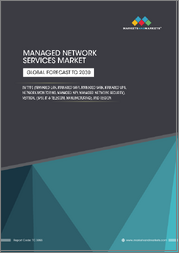
|
시장보고서
상품코드
1743348
네트워크 모니터링 시장 규모, 점유율, 성장 분석 : 제공별, 대역폭별, 기술별, 최종사용자별, 지역별 - 산업 예측(2025-2032년)Network Monitoring Market Size, Share, and Growth Analysis, By Offering (Equipment, Network TAPs), By Bandwidth (1&10 Gbps, 40 Gbps), By Technology, By End User, By Region - Industry Forecast 2025-2032 |
||||||
네트워크 모니터링 세계 시장 규모는 2023년에 43억 달러로 평가되었으며, 2024년 47억 9,000만 달러에서 2032년에는 112억 7,000만 달러로 성장하여 예측 기간(2025-2032년) 동안 CAGR 11.3%로 성장할 전망입니다.
세계 네트워크 모니터링 시장은 헬스케어, 에너지, 유틸리티 등 다양한 분야가 사이버 위협의 심각성으로 인해 보안을 우선시함에 따라 큰 폭의 성장이 예상됩니다. 기업들은 클라우드 도입, IoT 확산, 원격 근무 등 점점 더 복잡해지는 IT 환경에 직면하고 있으며, 고도화된 네트워크 모니터링 솔루션에 대한 수요가 급증하고 있습니다. 기업들은 기밀 정보를 보호하고 업무 효율성을 확보하기 위해 AI를 활용한 네트워크 분석과 위협 자동 탐지에 집중하고 있습니다. 데이터센터의 증가와 디지털 서비스로의 전환은 확장 가능하고 비용 효율적인 모니터링 도구의 필요성을 더욱 높이고 있습니다. 모니터링 시스템과 관련된 높은 비용은 성장의 걸림돌이지만, 업계 리더들은 정교하면서도 합리적인 가격의 솔루션을 개발하기 위해 혁신적인 노력을 기울이고 있으며, 이는 이러한 문제를 완화하고 시장 역학을 강화할 것으로 예상됩니다.
목차
소개
- 조사 목적
- 조사 범위
- 정의
조사 방법
- 정보 조달
- 2차와 1차 데이터 방법
- 시장 규모 예측
- 시장 가정과 제한
주요 요약
- 세계 시장 전망
- 공급과 수요 동향 분석
- 부문별 기회 분석
시장 역학과 전망
- 시장 개요
- 시장 규모
- 시장 역학
- 성장 촉진요인과 기회
- 성장 억제요인과 과제
- Porters 분석
주요 시장 인사이트
- 핵심성공요인
- 경쟁 정도
- 주요 투자 기회
- 시장 생태계
- 시장 매력 지수(2024년)
- PESTEL 분석
- 거시경제 지표
- 밸류체인 분석
- 가격 분석
네트워크 모니터링 시장 규모 : 제공별 & CAGR(2025-2032년)
- 시장 개요
- 장비
- 네트워크 TAP
- 데이터 모니터링 스위치
- 소프트웨어와 서비스
네트워크 모니터링 시장 규모 : 대역폭별 & CAGR(2025-2032년)
- 시장 개요
- 1 Gbps와 10 Gbps
- 40 Gbps
- 100 Gbps
네트워크 모니터링 시장 규모 : 기술별 & CAGR(2025-2032년)
- 시장 개요
- 이더넷
- 광섬유
- 인피니밴드
네트워크 모니터링 시장 규모 : 최종사용자별 & CAGR(2025-2032년)
- 시장 개요
- 기업
- 통신 업계
- 정부기관
- 클라우드 서비스 프로바이더
네트워크 모니터링 시장 규모 & CAGR(2025-2032년)
- 북미
- 미국
- 캐나다
- 유럽
- 독일
- 스페인
- 프랑스
- 영국
- 이탈리아
- 기타 유럽
- 아시아태평양
- 중국
- 인도
- 일본
- 한국
- 기타 아시아태평양
- 라틴아메리카
- 브라질
- 기타 라틴아메리카
- 중동 및 아프리카
- GCC 국가
- 남아프리카공화국
- 기타 중동 및 아프리카
경쟁 정보
- 상위 5개사의 비교
- 주요 기업의 시장 포지셔닝(2024년)
- 주요 시장 기업이 채용한 전략
- 최근의 시장 동향
- 기업의 시장 점유율 분석(2024년)
- 주요 기업 개요
- 기업 상세
- 제품 포트폴리오 분석
- 기업 부문별 점유율 분석
- 매출 전년비 비교(2022-2024년)
주요 기업 개요
- Datadog(USA)
- Microsoft(USA)
- Nagios Enterprises, LLC.(USA)
- Dynatrace(USA)
- Zabbix LLC(Latvia)
- SolarWinds Worldwide, LLC.(USA)
- ManageEngine(India)
- Cisco Systems, Inc.(USA)
- Paessler AG(Germany)
- Broadcom Inc.(USA)
- Keysight Technologies Inc.(USA)
- VIAVI Solutions Inc.(USA)
- NETSCOUT SYSTEMS, INC.(USA)
- Auvik Networks Inc.(Canada)
- Centreon(France)
결론과 제안
KSM 25.06.20Global Network Monitoring Market size was valued at USD 4.3 billion in 2023 and is poised to grow from USD 4.79 billion in 2024 to USD 11.27 billion by 2032, growing at a CAGR of 11.3% during the forecast period (2025-2032).
The global network monitoring market is gearing up for substantial expansion as various sectors, including healthcare, energy, and utilities, prioritize security due to escalating cyber threats. As organizations face increasingly complex IT environments from cloud adoption, IoT proliferation, and remote work, the demand for advanced network monitoring solutions is surging. Companies are focusing on AI-driven network analytics and automated threat detection to protect sensitive information and ensure operational efficiency. The rise in data centers and the shift towards digital services further fuel the need for scalable and cost-effective monitoring tools. Although the high costs associated with monitoring systems can hinder growth, industry leaders are innovating to develop sophisticated yet affordable solutions, promising to alleviate this challenge and enhance market dynamics.
Top-down and bottom-up approaches were used to estimate and validate the size of the Global Network Monitoring market and to estimate the size of various other dependent submarkets. The research methodology used to estimate the market size includes the following details: The key players in the market were identified through secondary research, and their market shares in the respective regions were determined through primary and secondary research. This entire procedure includes the study of the annual and financial reports of the top market players and extensive interviews for key insights from industry leaders such as CEOs, VPs, directors, and marketing executives. All percentage shares split, and breakdowns were determined using secondary sources and verified through Primary sources. All possible parameters that affect the markets covered in this research study have been accounted for, viewed in extensive detail, verified through primary research, and analyzed to get the final quantitative and qualitative data.
Global Network Monitoring Market Segments Analysis
Global Network Monitoring Market is segmented by Offering, Bandwidth, Technology, End User and region. Based on Offering, the market is segmented into Equipment, Network TAPs, Data Monitoring Switches and Software & Services. Based on Bandwidth, the market is segmented into 1&10 Gbps, 40 Gbps and 100 Gbps. Based on Technology, the market is segmented into Ethernet, Fiber Optic and InfiniBand. Based on End User, the market is segmented into Enterprises, Telecommunications Industry, Government Organizations and Cloud Service Providers. Based on region, the market is segmented into North America, Europe, Asia Pacific, Latin America and Middle East & Africa.
Driver of the Global Network Monitoring Market
In today's digital-first environment, organizations depend on robust and continuous network connectivity to facilitate essential functions like cloud computing, video conferencing, and e-commerce. The increasing intricacy of networks, particularly with the rise of multi-cloud and hybrid systems, has rendered real-time monitoring vital for operational success. Cutting-edge, AI-driven network monitoring solutions empower businesses to identify anomalies, foresee potential failures, and enhance performance instantaneously. By incorporating advanced technologies such as deep packet inspection (DPI), machine learning-based anomaly detection, and predictive analytics, companies can significantly reduce downtime and maintain smooth network operations, ensuring they meet the demands of their customers and stakeholders effectively.
Restraints in the Global Network Monitoring Market
A significant barrier to the adoption of advanced network monitoring solutions in the global market is the elevated costs associated with both deployment and ongoing maintenance. While large enterprises may have the financial capacity to invest in AI-powered network analytics, automation tools, and sophisticated sensors, small and medium-sized businesses (SMBs) frequently encounter affordability challenges. The expenses linked to hardware sensors, software licenses, cloud storage, and the hiring of skilled IT personnel to oversee the monitoring systems can be quite daunting. Furthermore, the complexity and high costs associated with integrating these advanced solutions into existing legacy systems deter many businesses from transitioning from traditional monitoring tools to AI-driven alternatives due to financial apprehensions.
Market Trends of the Global Network Monitoring Market
The Global Network Monitoring market is increasingly influenced by the integration of AI-driven network automation and predictive analytics, a trend set to dominate through 2024 and beyond. This shift allows organizations to enhance their operational efficiencies by employing advanced machine learning algorithms for anomaly detection, bandwidth optimization, and predictive system maintenance. For instance, the launch of Juniper Networks' innovative AI-powered platform reflects the industry's pivot towards proactive network management, empowering enterprises to anticipate and address potential failures before they manifest. Furthermore, AI-enhanced monitoring systems bolster cybersecurity by detecting threats in real-time, significantly improving response times and ensuring robust network performance.
Table of Contents
Introduction
- Objectives of the Study
- Scope of the Report
- Definitions
Research Methodology
- Information Procurement
- Secondary & Primary Data Methods
- Market Size Estimation
- Market Assumptions & Limitations
Executive Summary
- Global Market Outlook
- Supply & Demand Trend Analysis
- Segmental Opportunity Analysis
Market Dynamics & Outlook
- Market Overview
- Market Size
- Market Dynamics
- Drivers & Opportunities
- Restraints & Challenges
- Porters Analysis
- Competitive rivalry
- Threat of substitute
- Bargaining power of buyers
- Threat of new entrants
- Bargaining power of suppliers
Key Market Insights
- Key Success Factors
- Degree of Competition
- Top Investment Pockets
- Market Ecosystem
- Market Attractiveness Index, 2024
- PESTEL Analysis
- Macro-Economic Indicators
- Value Chain Analysis
- Pricing Analysis
Global Network Monitoring Market Size by Offering & CAGR (2025-2032)
- Market Overview
- Equipment
- Network TAPs
- Data Monitoring Switches
- Software & Services
Global Network Monitoring Market Size by Bandwidth & CAGR (2025-2032)
- Market Overview
- 1&10 Gbps
- 40 Gbps
- 100 Gbps
Global Network Monitoring Market Size by Technology & CAGR (2025-2032)
- Market Overview
- Ethernet
- Fiber Optic
- InfiniBand
Global Network Monitoring Market Size by End User & CAGR (2025-2032)
- Market Overview
- Enterprises
- Telecommunications Industry
- Government Organizations
- Cloud Service Providers
Global Network Monitoring Market Size & CAGR (2025-2032)
- North America (Offering, Bandwidth, Technology, End User)
- US
- Canada
- Europe (Offering, Bandwidth, Technology, End User)
- Germany
- Spain
- France
- UK
- Italy
- Rest of Europe
- Asia Pacific (Offering, Bandwidth, Technology, End User)
- China
- India
- Japan
- South Korea
- Rest of Asia-Pacific
- Latin America (Offering, Bandwidth, Technology, End User)
- Brazil
- Rest of Latin America
- Middle East & Africa (Offering, Bandwidth, Technology, End User)
- GCC Countries
- South Africa
- Rest of Middle East & Africa
Competitive Intelligence
- Top 5 Player Comparison
- Market Positioning of Key Players, 2024
- Strategies Adopted by Key Market Players
- Recent Developments in the Market
- Company Market Share Analysis, 2024
- Company Profiles of All Key Players
- Company Details
- Product Portfolio Analysis
- Company's Segmental Share Analysis
- Revenue Y-O-Y Comparison (2022-2024)
Key Company Profiles
- Datadog (USA)
- Company Overview
- Business Segment Overview
- Financial Updates
- Key Developments
- Microsoft (USA)
- Company Overview
- Business Segment Overview
- Financial Updates
- Key Developments
- Nagios Enterprises, LLC. (USA)
- Company Overview
- Business Segment Overview
- Financial Updates
- Key Developments
- Dynatrace (USA)
- Company Overview
- Business Segment Overview
- Financial Updates
- Key Developments
- Zabbix LLC (Latvia)
- Company Overview
- Business Segment Overview
- Financial Updates
- Key Developments
- SolarWinds Worldwide, LLC. (USA)
- Company Overview
- Business Segment Overview
- Financial Updates
- Key Developments
- ManageEngine (India)
- Company Overview
- Business Segment Overview
- Financial Updates
- Key Developments
- Cisco Systems, Inc. (USA)
- Company Overview
- Business Segment Overview
- Financial Updates
- Key Developments
- Paessler AG (Germany)
- Company Overview
- Business Segment Overview
- Financial Updates
- Key Developments
- Broadcom Inc. (USA)
- Company Overview
- Business Segment Overview
- Financial Updates
- Key Developments
- Keysight Technologies Inc. (USA)
- Company Overview
- Business Segment Overview
- Financial Updates
- Key Developments
- VIAVI Solutions Inc. (USA)
- Company Overview
- Business Segment Overview
- Financial Updates
- Key Developments
- NETSCOUT SYSTEMS, INC. (USA)
- Company Overview
- Business Segment Overview
- Financial Updates
- Key Developments
- Auvik Networks Inc. (Canada)
- Company Overview
- Business Segment Overview
- Financial Updates
- Key Developments
- Centreon (France)
- Company Overview
- Business Segment Overview
- Financial Updates
- Key Developments



















